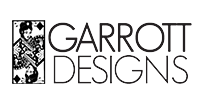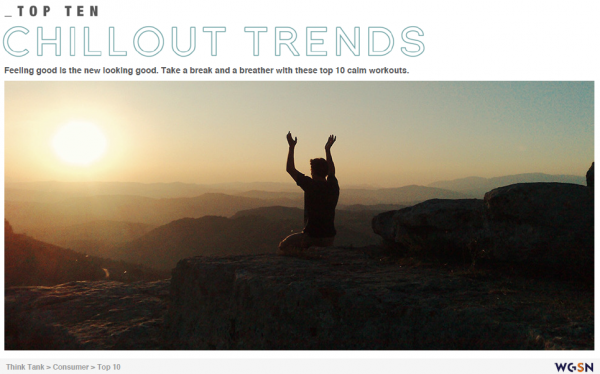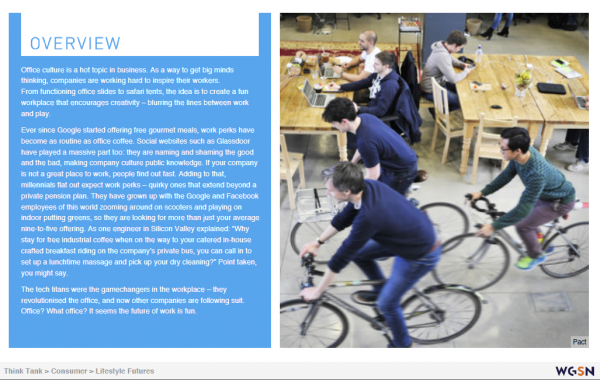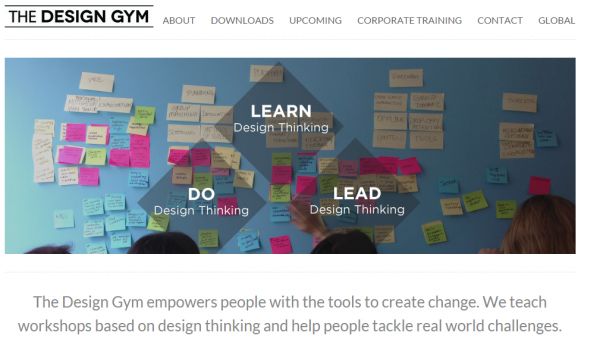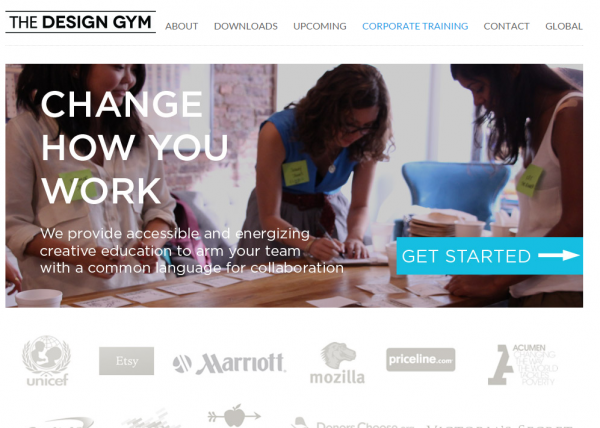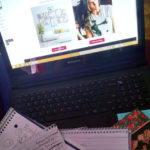Creative Culture: Thinking InsideOut of the Box
Neuroscientists and innovation gurus are advocating that the creative process works best with periods of relaxed awareness and restful thinking. This isn’t a new idea but it is one that is currently being rediscovered. Several, recent WGSN cultural trend reports and various articles have shown that practices are being adopted in Silicon Valley and innovation firms across the globe. Companies like LinkedIn and Spotify are designing work space around some of these forward thinking ideas.
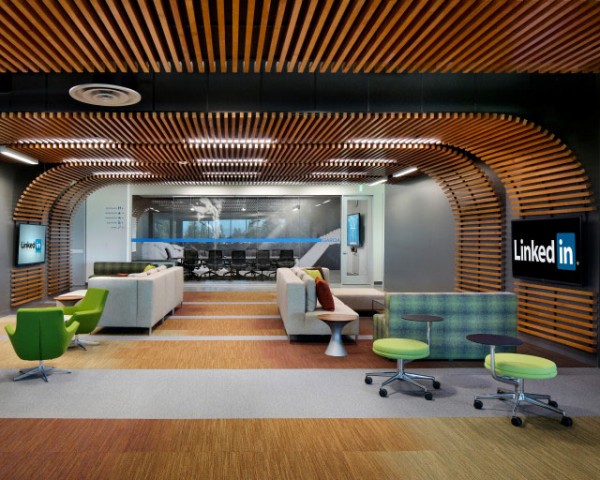
LinkedIn Office
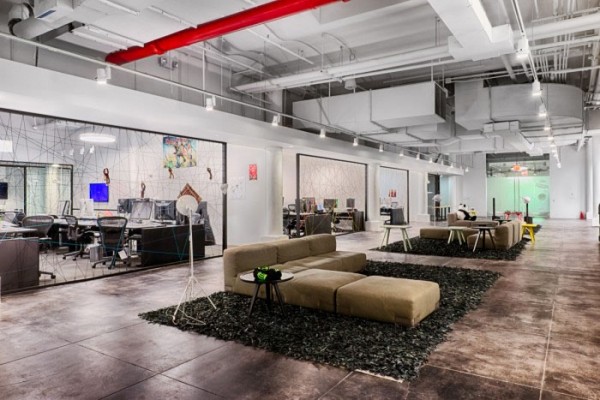
Spotify Office
I recently attended a Designers + Geeks lecture at Spotify on the subject of Product By Design. The lecture highlighted apps that enable collaboration and intuitive user experience. In hearing how these experts work, it is clear that the work, flow, life culture is effective. It’s not to say that stress is exempt, but that relaxed awareness and engagement is fostered through a collaborative, nontraditional environment. Deadlines and challenges are constant while people are enabled with the head space and floor space to solve problems.

Designers + Geeks at Spotify
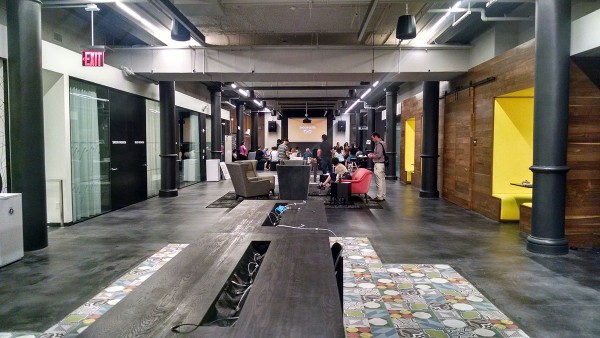
Spotify Office
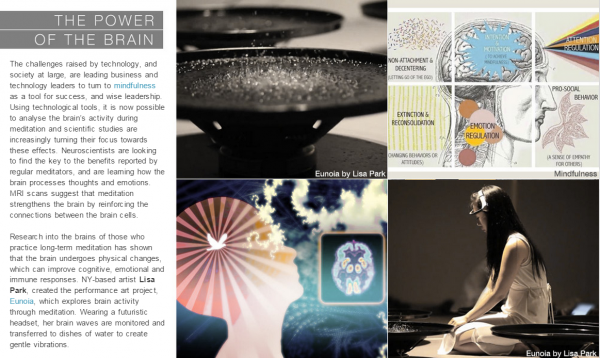
Style Sight WGSN “Inner-Net” Report 2013
Technology allows us to work from anywhere but it also forces us to work from anywhere. How do we stay connected to our goals in a frenzied life of interruption? How do we prioritize projects instead of letting breakdowns prioritize them for us?
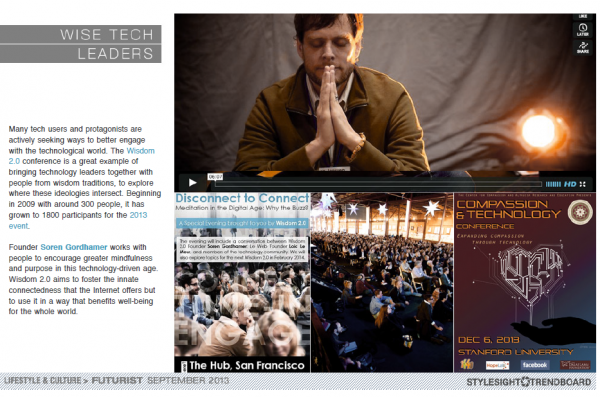
Style Sight WGSN Lifestyle & Culture “Futurist” 2013 Report
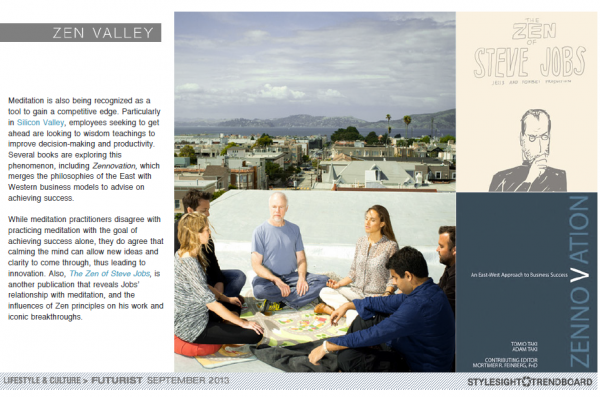
Style Sight WGSN Lifestyle & Culture “Futurist” 2013 Report
Even Steve Jobs is known for taking time for meditation and calligraphy classes. Relaxed awareness is how we connect the seemingly unrelated dots that change the way we see things. Since reading the above ‘StyleSight’ report in 2013, the practice of reflective thinking remained a personal habit, though I wasn’t interested in meditation. Just sitting and being “clear headed” won’t get anything done! I read “Zennovation” and I’d highly recommend it. Tomio Taki was behind the success of Donna Karen New York, and many other ventures. His product development stories and creative solutions are priceless lessons. I also read ‘Style Sight’ recommended, Conscious Capitalism and Business Secrets of a Trappist Monk, both have worthy anecdotes as well but read a bit like an infomercial. I continued to read anything else that overachievers wrote to help find peace with an active mind.
Recently, a WGSN report ’Top 10 Chill Out Trends’, informed me of a meditation group for live and active cultures; The PATH. (See a full copy of this report at WGSN.com )
The Path experience may not be for everyone but it did awaken me to a group of highly effective people who do sit around and “do nothing” for a little while every day. What intrigues me about the PATH was their purpose. (I love purpose).
“The Path teaches ancient meditation techniques in a modern way. We guide you through four types of meditation: energizing, mindfulness, mantra and intention-setting. Each has a powerful, and different, effect on the mind. By teaching you all four, we give you the tools to create a custom meditation practice, designed just for you.”
Intention-setting! Sign me up. Though it was only one session and went awkwardly. I did find, for about 24 hours after the experience, I was able to calmly prioritize my objectives and mindfully proceed with the one thing I was doing in the moment. After that, my anxiety reconvened. What I learned is that, taking a moment to deliberately re-purpose your mind in the present can help you better achieve contentment with the work/life/flow.
Another element to The PATH is an hour of “networking”. What a dirty word, I prefer inspiration camaraderie. An hour long chance to talk with other productive people about their experience, their projects and perhaps collaborate. How cool is that?
A second cultural trend emerging in big companies and start up’s alike is the habit of Collaboration and Play. (See the full ‘Think Tank’ report at WGSN.com)
So I joined The Design Gym. TDG is an organization that teaches the “Design Thinking” method of creative problem solving and collaboration. It’s not a new social science, much of its establishment was founded in the 1960’s. However, it’s gaining speed as the new “Big Picture” in forward business philosophy.
Through this experience, I’ve learned that better ideas come from everyone in the room. A “Brain Trust”, is a team that enables each other’s strengths while complimenting their weaknesses and can power through a project with stellar results. Cultivating the kind of environment where people feel safe to toss out ideas, to share the load and dedicate their efforts to the best possible solution, as opposed to individual objectives, takes practice. The Design Gym offers classes in facilitation and extracting top to bottom and bottom to top problem/solution articulation. A great book that perfectly illustrates the potentials of a good “Brain Trust” is “Creativity Inc.” by Ed Catmull of Pixar.
What all of this research points to is that creating and delivering the best possible product while defining a brand is an organic process that occurs best with personal attention to a community environment that is an open source brain trust of thinking differently, together.
